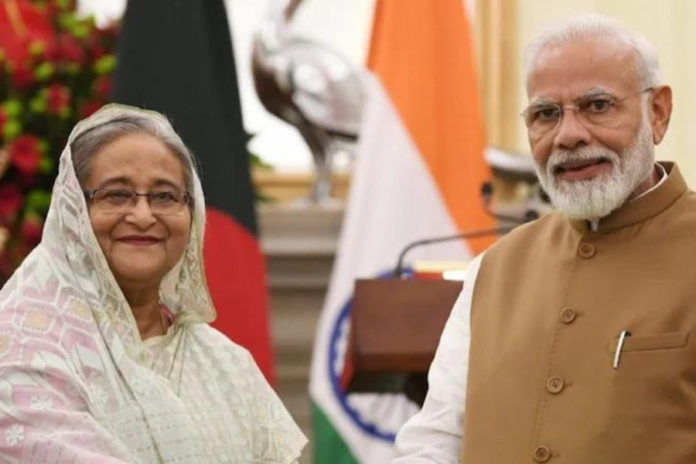India has launched a charm drive in an attempt to free Bangladesh from Chinese influence. Following two consecutive visits by Prime Minister Narendra Modi to her counterpart, Prime Minister Sheikh Hasina of Bangladesh, Admiral Dinesh Tripathi, the newly appointed head of the Indian Navy, made Dhaka his first official destination. Bangladesh has secured an 800-ton ocean-going tug from an Indian shipyard, in addition to other marine matters that the Indian Navy Chief will address.
It is unclear if the tugboat from Garden Reach Shipbuilders and Engineers (GRSE) in Kolkata will be compatible with the Type 035G diesel-electric attack submarines that China sent to Bangladesh. These submarines are Ming-class variants.
China is also constructing a submarine base in Bangladesh; given its proximity to India’s Eastern Naval Command, India will be concerned if the Chinese Navy gains access to this key facility.
Following the formation of the new Indian administration, Prime Minister Modi summoned Prime Minister Sheikh Hasina as his first guest.
The Teesta River Comprehensive Management and Restoration Project was offered management by the Indian government. China is interested in the project, whose estimated cost is $1 billion.
Beijing and India have jointly submitted an official proposal to carry out this project. The necessity to keep China away from the river that flows into India is the reason behind New Delhi’s willingness to finance the project.
In addition, the river is strategically and geopolitically significant. The region is nearer the treacherous “Chicken Neck” route that links northeastern India with the rest of the nation. On the project, Dhaka has not yet made a decision.
A Memorandum of Understanding (MoU) regarding train travel between Bangladesh and India was also signed by India and Bangladesh in Dhaka, Delhi. Train connectivity between India, Bangladesh, Nepal, and Bhutan will be made possible by an agreement. In an attempt to strike a balance between the two Asian powers, Prime Minister Hasina will be in China from July 8 to 11.
In light of this, it is crucial to strengthen ties with Bangladesh, which is why the Indian Navy Chief is in Bangladesh. Bangladesh has made the decision to join the Indo-Pacific Oceans Initiative (IPOI), a forum that India has spearheaded to bring nations together to find cooperative answers to the Indo-Pacific region’s shared problems. Admiral Tripathi and his counterpart in Bangladesh, Admiral M Nazmul Hassan, will talk about the passing-out parade at the Bangladesh Naval Academy (BNA), Chittagong (now named Chattogram), during the five-day visit.
Admiral Tripathi is scheduled to meet with Air Marshal Hasan Mahmood Khan of the Bangladesh Air Force and General Waker-Uz-Zaman of the Bangladesh Army. During its week-long stay in Chattogram, the Indian cruiser INS Ranvir will work with the Bangladesh Navy on a maritime cooperation exercise.
China is assisting the Bangladesh Navy in the construction of a dry dock at Chittagong. Located in Cox’s Bazar, the US $1.2 billion Sheikh Hasina submarine complex can accommodate six submarines and eight warships concurrently. The facility is expected to be accessible to Chinese submarines in the future, given that the Bangladesh Navy currently possesses just two Chinese submarines.
Bangladesh’s prime minister, Sheikh Hasina, officially opened the base in March 2023. Chinese officials and a minimum of two senior PLA-N commanders were present during the ceremony. permitting “safe and swift movement of the submarines in case of emergency,” as the Dhaka Tribune reported last year.
India, China competing over Bangladesh, Bay of Bengal
Nestled between Indonesia on the west and India on the east is the largest bay in the world, known as the Bay of Bengal. The countries bordering the sea include Myanmar, Bangladesh, and Sri Lanka. The importance of the region in terms of trade, diplomacy, and security draws major players from both the East and the West, including the US, China, Japan, India, and even Russia.
The marine routes of communication that link China, Japan, and Korea to the Middle East and Africa are topped by the Bay of Bengal. These channels handle half of global trade. The area is critical to US policy of a “Free, open, and inclusive Indo-Pacific,” which is code for reining down China’s belligerence.
Due to the significance of the Bay of Bengal, Bangladesh and Myanmar have been added to the US Department of Defense’s list of places where Beijing is probably trying to build military bases abroad.
India views the Bay of Bengal as its direct sphere of influence, and it has been strengthening the littoral nations’ military power. But when it comes to purchasing power, China has outdone India. Bangladesh is a prominent importer of defense equipment from China. China’s assistance in the construction of the submarine base in Bangladesh may not worry India too much, but Chinese submarines in its own neighborhood are a whole other story.
Also Read: How India is realising global goals with aggressive foreign policy
India is strengthening its position in the Andaman and Nicobar Islands, which are located on the Malacca Strait—a vital chokepoint for China—in light of China’s growing influence in the Bay of Bengal.
India benefits from the Malacca Strait’s shallow water, which forces Chinese submarines entering the Bay of Bengal to surface. This is why there is a drive to arm the islands of Andaman and Nicobar with more military hardware.



